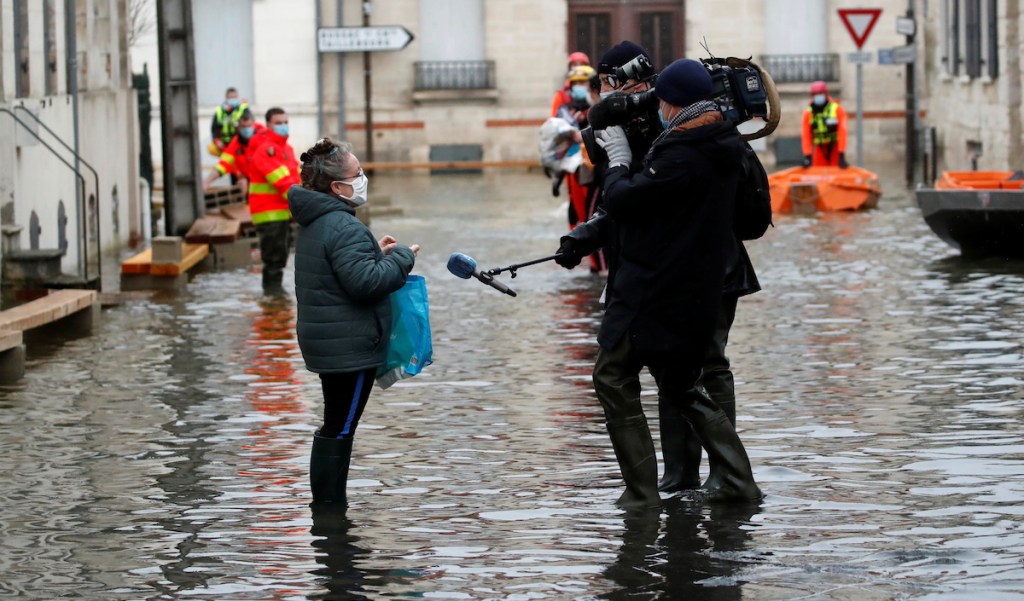Rising global temperatures are increasing the potential for flooding. Floods can occur not only during heavy rains, but also when ocean waves are being pushed onshore, when snow is melting quickly, or when dams or levees break. Flash floods are particularly dangerous, because they combine the destructive power of a flood with incredible speed. Flooding can also occur when there is no rain, a phenomenon that is often referred to as “tidal flooding” or “sunny day flooding.”
Floods can result in the loss of life and in damages to property and the environment. Each year, flooding causes more deaths than any other storm-related hazard, according to the U.S. Centers for Disease Control and Prevention. To help minimize the risks, editors and journalists should consider the following safety information and plan accordingly.
Pre-Assignment
- Prepare to be self-sufficient in case you cannot rely on support from aid agencies. Consider bringing non-perishable foods, a head torch, multi-tool, can opener, tent, and an appropriate sleeping bag. Also bring a decent amount of cash to pay for things on the ground, especially if credit card payment systems don’t work.
- Keep in mind that while being fully equipped is essential, there is a balance between the weight of equipment you have to carry and being fully prepared.
- Access to clean drinking water is likely to be an issue, so consider taking water purification tablets, a reusable filter bottle, or a portable water purification system. You may need to take a supply of drinkable water with you in extreme circumstances.
- Complete a thorough risk assessment, detailing contingency plans and medical evacuation procedures. Develop a check-in procedure for the duration of your trip, and plan to communicate regularly with your news desk or team about your plans and whereabouts. Identify key authorities or other individuals who can be called upon in an emergency. Note that you may have to update your risk assessment during the trip, depending on changing events on the ground.
- Take a well-stocked individual first aid kit.
- While en route and during the assignment, keep up-to-date on weather forecasts. A rapidly deteriorating scenario may require a change of plans.
- Dress appropriately for the conditions, with suitable footwear that has sufficient ankle support. Cuts to feet can easily become infected, so ensure your feet are completely protected.
- Make sure your passport, visas, immunization records, and other documentation are handy and stored in a waterproof container.
On Location
- On arrival, identify a safe accommodation or place to shelter with food and water (if possible), which may be unavailable or in short supply in areas with high levels of destruction. If necessary, stay outside the epicenter of the flood damage and make trips into the affected area. Avoid large glass windows and corrugated sheet roofs if reporting in stormy conditions. Be mindful of where you are staying: Keep away from areas that are prone to flooding, such as low spots, canyons, and washes.
- Work out an exit strategy and safe place to fall back to, if necessary. Identify medical facilities and locations where you can seek assistance in case of an emergency. If you need to evacuate, turn off the utilities using the main power switch and close the main gas line (if applicable) before leaving your accommodation.
- Always have access to safe and reliable transportation in case you need to leave quickly. Never rely on public transport or taxis.
- Before you leave for your assignment, prepare by fully reviewing guidance about how to exit your car if it becomes submerged in water. If your vehicle is suddenly stuck in rising water, get out immediately and find higher ground. If your car becomes submerged, don’t panic. Some fire departments advise waiting for the vehicle to fill with water and opening the car door once the vehicle is full, before swimming to the surface. Once you are outside of the car, it’s advisable to point your feet downstream if you’re swept into fast-moving floodwater. Remember to always go above obstacles, not underneath them.
- Do not walk across flooded roads or streams. The water might be faster than it looks, and it takes as little as six inches of water to knock someone off their feet. Be especially careful at night, when flood conditions are harder to see.
- Be aware of drains or down holes and uncovered manholes when walking around flooded areas.
- Be aware that standing water can pose a significant health risk. It can contain sewage and chemical hazards and spread infectious diseases.
- Sanitize your hands regularly, and do not expose open wounds to water, due to the risk of infection.
- Local telecommunication networks might be disrupted or down, so consider taking satellite phones and a BGAN (Broadband Global Area Network) terminal, if legal and safe to use in the country. Be sure to communicate regularly with your news desk or team about your plans and whereabouts as part of your agreed upon check-in procedure.
- Be alert for any escaped wildlife.
Sources:
